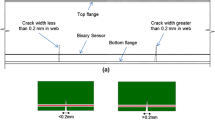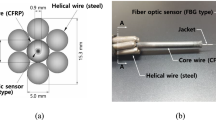Abstract
Steel girder bridges make up a significant percentage of all bridges. Many of the steel girder bridges are aging and approaching their designed service lives. Crack formation and its propagation over time is one of the main deficiencies of aging steel girders and may result in unusable or unsafe service conditions. The existing distributed crack detection methods such as fiber optics sensors are costly to deploy and maintain. A new cost effective binary sensor has been developed, has the potential to be installed on steel girder bridges at a fraction of the cost, and is sensitive enough to detect the presence of a crack opening with a width of 0.2 mm. The crack sensor is a closed electrical circuit and comprised of copper wire and epoxy. When a crack forms in the steel girder, the strain will be transferred to the wire through the adhesive. As the crack on the girder widens over time, strains in the wire increase until it reaches its ultimate tensile strain. The wire then fractures and creates an open circuit. This can be detected by monitoring the electrical continuity of the sensor. One of the main challenges in developing the binary sensor is to select appropriate materials for both wire and adhesive. The final tensile strain as well as the bonding stiffness between the wire and the epoxy have important impacts on the performance of the sensor. In this work, pre-straining the sensor wire was found to be effective in minimizing the width of the detected crack opening. The average was reduced from 0.36 to 0.13 mm and the standard deviation reduced from 0.16 to 0.03. In addition, microbond test was carried on to estimate the interfacial-bonding stiffness between wire and epoxy. The interfacial stress was found to be approximately 2.0 MPa. These parameters were used in a finite-element model of the sensor to predict the behaviour of the binary sensor and, consequently, to optimize the installation position of the sensor on a girder of a bridge.











Similar content being viewed by others
References
Chase SB, Washer G (1997) Nondestructive evaluation for bridge management in the next century. Public Roads 61(1):16–26
ASCE (2017) Infrastructure report card, a comprehensive assessment of America’s infrastructure. American Society of Civil Engineers, Washington, D.C.
ISIS Canada (2004) ISIS Canada educational module 5: an introduction to structural health monitoring
Ghorbanpoor A, Benish N (2003) Wisconsin highway research program: non-destructive testing of Wisconsin highway bridges. Wisconsin DOT, Milwaukee
Lamtenzan D, Washer G, Lozev M (2000) Detection and sizing of cracks in structural steel using the eddy current method (Federal Highway Administration, McLean) Report No.: FHWA-RD-00-018
Chajes M, Mertz D, Quiel S (2005) Steel girder fracture on Delaware’s I-95 bridge over the brandywine river. In: Proceedings of the 2005 ASCE structures congress (ASCE, New York)
Ellis R, Conner R (2013) Investigation and repair of the Diefenbaker bridge fracture. Transportation Association of Canada (Winnipeg)
FHWA (2012) Feasibility of nondestructive crack detection and monitoring for steel bridges (FHWA, McLean) Report No.: FHWA-HRT-12-060
Chang PC, Liu SC (2003) Recent research in nondestructive evaluation of civil infrastructures. Mater Civ Eng 15(June):298–304
Chang PC, Flatau A, Liu SC (2003) Review paper: health monitoring of civil infrastructure. Struct Heal Monit 2(3):257–267
Collins J, Mullins G, Lewis C, Winters D (2014) State of the practice and art for structural health monitoring of bridge substructures (FHWA, McLean) Report No.: FHWA-HRT-09-040
Mufti A, Thomson D, Inaudi D, Vogel HM, McMahon D (2011) Crack detection of steel girders using Brillouin optical time domain analysis. J Civ Struct Heal Monit 1(3–4):61–68
Raeisi F, Mufti A, Mustapha G, Thomson DJ (2017) Crack detection in steel girders of bridges using a broken wire electronic binary crack. J Civil Struct Health Monit 7(2):233–243
Sigurdardottir DH, Glisic B (2015) The neutral axis location for structural health monitoring: an overview. J Civ Struct Heal Monit 5(5):703–713
Ni YQ, Xia HW, Ye XW (2012) Neutral-axis position based damage detection of bridge deck using strain measurement: numerical and experimental verifications. In: 6th European Workshop on Structural Health Monitoring (Dresden,Germany)
Carden EP, Fanning P (2004) Vibration based condition monitoring: a review. Struct Heal Monit 3(4):355–377
Farrar RC, Darling TW, Migliori A, Baker WE (1999) Microwave interferometers for non-contact vibration measurements on large structures. Mech Syst Signal Process 13:241–253
Zhang B, Wang S, Li X, Zhang X, Yang G (2014) Crack width monitoring of concrete structures based on smart film. Smart Mater Struct. https://doi.org/10.1088/0964-1726/23/4/045031
Zhou Z, Zhang B, Xia K, Li X (2015) Smart film for crack monitoring of concrete bridges. Struct Heal Monit 10:275–289
Glisic B, Inaudi D (2011) Development of method for in-service crack detection based on distributed fiber optic sensors. Struct Heal Monit. https://doi.org/10.1177/1475921711414233
Enckell M (2011) Lessons learned in structural health monitoring of bridges using advanced sensor technology. Dissertation (KTH)
Raeisi F, Mufti A, Mustapha G, Thomson DJ, Eden R (2017) Investigation of the influence of breaking strain and temperature on a binary crack sensor. In: 8th international conference on structural health monitoring of intelligent infrastructures (Brisbane, Australia)
ASTM Standard C1557—14 standard test method for tensile strength and Young’ s modulus of fibers (2016) (ASTM) https://doi.org/10.1520/c1557-14.2
ASTM Standard D638-10 Standard test method for tensile properties of plastics (2010) (ASTM) https://doi.org/10.1520/d0638-10
Nishikawa M, Okabe T, Hemmi K, Takeda N (2008) Micromechanical modeling of the microbond test to quantify the interfacial properties of fiber-reinforced composites. Int J Solids Struct 45(14–15):4098–4113
Sockalingam S, Nilakantan G (2012) Fiber-matrix interface characterization through the microbond test. Int J Aeronaut Sp Sci 13(3):282–295
Technical Data Sheet-Loctite EA E-20NS (2013)
Qi HJ, Joyce K, Boyce MC (2003) Durometer Hardness and The Stress-Strain Behavior of Elastomeric Materials. Rubber Chem Technol 76(2):419–435
DiFrancia C, Ward TC, Claus RO (1996) The single-fibre pull-out test. 1: review and interpretation. Compos Part A Appl Sci Manuf 27(8 PART A):597–612
Rao SS (2011) The finite element method in engineering, 5th edn. Elsevier. ISBN: 978-1-85617-661-3
ABAQUS (2014) Getting Started with Abaqus: Interactive Edition (Dassault Systèmes Simulia Corp. Providence, RI, USA)
Camanho P, Dvila CG (2002) Mixed-mode decohesion finite elements in for the simulation composite of delamination materials (NASA), Report No: L-18194
ABAQUS (2014) Abaqus analysis user guide. V (Dassault Systèmes Simulia Corp., Providence, RI, USA)
Khalighi Y (2009) A study of bond between fibre reinforced polymer and concrete under quasi-static and impact. Dissertation (University of British Columbia)
Acknowledgements
The authors wish to express their gratitude and appreciation for the supports received from the following organizations: Natural Science and Engineering Research Council of Canada, Canada Foundation for Innovation, Research Manitoba, Canadian Microelectronic Corporation, and Structural Monitoring Technologies.
Author information
Authors and Affiliations
Corresponding author
Additional information
Publisher's Note
Springer Nature remains neutral with regard to jurisdictional claims in published maps and institutional affiliations.
Electronic supplementary material
Below is the link to the electronic supplementary material.
Rights and permissions
About this article
Cite this article
Raeisi, F., Mufti, A. & Thomson, D.J. A finite-element model and experimental investigation of the influence of pre-straining of wire on the sensitivity of binary crack sensors. J Civil Struct Health Monit 8, 673–687 (2018). https://doi.org/10.1007/s13349-018-0290-7
Received:
Accepted:
Published:
Issue Date:
DOI: https://doi.org/10.1007/s13349-018-0290-7




